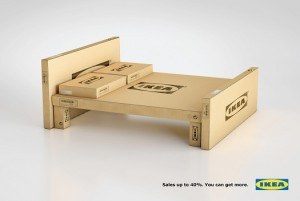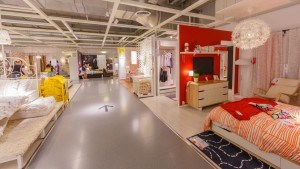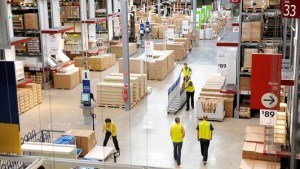IKEA: cutting costs, creating value

The home-furnisher who gets their customer do the heavy lifting
Our generation has become well acquainted with the low cost home-furnisher IKEA. We are willing to do our own delivery and assembly in exchange for the low cost and relatively attractive design that IKEA offers. IKEA’s ability to minimize cost goes beyond asking customers to do the heavy lifting in the store and carries out throughout their supply chain.
From design concept to easy to follow picture assembly instructions, IKEA focuses on creating products that will improve their customers’ homes and lives. In order to do this at prices that are so deeply discounted to the competition, IKEA has built a very effective supply chain.
Step 1: Product Design
IKEA’s products are designed to be functional and useful for the masses. The IKEA design process is based on studying actual homes and then working to combine quality, form, function, sustainability, and of course low price. The combination of these goals are labeled by IKEA as “democratic design” and is what they believe gives them a competitive advantage. Designers take into account what customer’s really care about when allocating costs to a piece of furniture. Expensive finish on the back of a bookshelf is not going to be noticed, so IKEA skips it. Pieces are designed to include minimal parts both to cut down on supplier cost, but also so that it is easy for the customer to assemble. [1]
Step 2: Product Procurement
IKEA has developed long term partnerships with their suppliers. They work with their suppliers on everything from wood sourcing to the actual product design. The high volume of their ordering not only means that the suppliers are eager to please them, but also that they can again keep costs much lower than competitors. The supplier partnership can be seen through the process of the FJÄLLBERGET chair (video: The IKEA Design Process for the FJÄLLBERGET Chair). IKEA’s team works to create “upscale” design ideas and then goes directly to their supplier to collaborate on a low cost version. They look to use raw materials in innovative new ways or create new materials with which to produce their goods. For example, they partnered with particle-board producers to create a new particle-board alternative. The new boards reduced the need for raw materials by 85,816 tons. Beyond helping the environment, this decreased the weight of cargo, meaning 2,800 less trucks were needed for transportation, further helping IKEA lower costs. [1, 2, 3]
 Step 3: Transportation
Step 3: Transportation
Once goods are produced they are packaged and economically packed on pallets for shipping. Most noticeably, almost all packages are flat which allow for lower shipping costs. The pallets are filled to maximum capacity, unlike peers who often ship assembled furniture. Not only does this help IKEA’s supply chain, it also makes it easier for the customer to pick up items in the store and take them home in these same space saving boxes. [3]
Step 4: The store/warehouse
IKEA describes their relationship with their customers as a partnership. By putting some of the work on the customers, IKEA is able to significantly lower the price. The store is where this partnership is most clearly on display, with showrooms set up to display the furniture, but then the customer is asked to pick up the pieces from a warehouse and deliver and assemble on their own (or pay for a service if they need assistance).
From the Customer’s Perspective:
IKEA sells to young consumers and families and has set up the layout of the store to be a destination for people to come with inexpensive family meals  and play areas for kids. The physical layout also drives sales with customers forced to walk through almost all departments of the store to reach the exit, leading to additional impulse buys. Buyers are able to see the furniture displayed in model rooms, showing the aesthetic appeal of the assembled furniture before going to the warehouse to pick up the boxed pieces. While certainty not a hassle free process, furniture tends to be in stock and the relatively simple pick-up and check-out process are now a normal element of furniture shopping for many IKEA loving customers. [4]
and play areas for kids. The physical layout also drives sales with customers forced to walk through almost all departments of the store to reach the exit, leading to additional impulse buys. Buyers are able to see the furniture displayed in model rooms, showing the aesthetic appeal of the assembled furniture before going to the warehouse to pick up the boxed pieces. While certainty not a hassle free process, furniture tends to be in stock and the relatively simple pick-up and check-out process are now a normal element of furniture shopping for many IKEA loving customers. [4]
From IKEA’s Perspective
While IKEA stores are rarely located inside a main city (although within driving distance), the company still focuse s on maximizing the efficiency of store space. This is done by putting the warehouse inside the store. After browsing the showrooms, customers enter the warehouse and pick up their items before check-out. Items are stacked in piles only high enough for customers to reach and additional inventory is stored above and lifted down by forklift at night. Inventory management is done in store which IKEA believes helps to prevent stock-outs, increasing customer satisfaction. Specifically, IKEA focuses on a “Cost-per-touch” inventory system, which is driven by the thought process that the more IKEA hands that touch a product the more expensive it becomes. Instead IKEA is able to transfer much of the heavy lifting (literally) to the customers who get the cost savings. [5]
s on maximizing the efficiency of store space. This is done by putting the warehouse inside the store. After browsing the showrooms, customers enter the warehouse and pick up their items before check-out. Items are stacked in piles only high enough for customers to reach and additional inventory is stored above and lifted down by forklift at night. Inventory management is done in store which IKEA believes helps to prevent stock-outs, increasing customer satisfaction. Specifically, IKEA focuses on a “Cost-per-touch” inventory system, which is driven by the thought process that the more IKEA hands that touch a product the more expensive it becomes. Instead IKEA is able to transfer much of the heavy lifting (literally) to the customers who get the cost savings. [5]
Conclusion
IKEA’s business model is based on aesthetically pleasing goods that are sold at great prices. The supply chain is integrated from the start to focus on cost cutting measures and thus no single aspect drives the incredible success IKEA has seen. The integrated process has made it very difficult for competitors to compete on price or design, leaving IKEA at the top of its target market.
Sources
[1] http://www.ikea.com/ms/en_JP/this-is-ikea/democratic-design/
[1, accompanying video] https://www.youtube.com/watch?v=1jn2_nZrivQ
[2] https://www.youtube.com/watch?v=jU-imkEarvU
[3] http://www.ikea.com/us/en/ts_dynamic/dynamiclist/filt_nel_glob?filter=-1
[4] Personal experience shopping at IKEA
[5] http://www.supplytimes.com/inventory-management/ikeas-inventory-management-strategy-why-it-works/?mode=featured



As someone who’s purchased and assembled a fair share of IKEA furniture, I thought this was a great read! Did not realize previously what a great job they did with suppliers to get costs down and create designs that make it more efficient to produce and ship. The cost per touch inventory system also was something I had never heard about but makes a great deal of sense in this type of business. One thing that will be interesting to watch unfold is how IKEA adapts/embraces the e-commerce space given what a strong reputation their customer experience has at their stores and the fact their stores also double as their warehouses.
Thanks for this great post Perry! As a loyal client of Ikea, I enjoyed this article a lot.
I agree that one of the great aspects of the Ikea model is that it gives me the choice to “do-it-myself” and save on the assembly costs instead of buying the assembled furniture paying a higher price.
The in-store physical layout, as you mention in the article, is another of Ikea’s brilliant ideas to drive sales. Many times I’ve been to Ikea with the idea of buying two or three specific things and I’ve ended up leaving the store with a big bag full of Ikea products (those impulse buys…).
Another aspect that I value is that most of Ikea’s products and packaging are environmentally friendly, something that Ikea has been doing for decades, long before its competitors.
For all the reasons that you explain in the article, I also agree that Ikea is a clear winner. And even when its competitors have attempted to replicate the model, none of them has still managed to reach Ikea’s standards.
Perry, great article. I certainly agree that IKEA improved its operating model almost to perfection. I had the chance to get deeper insights into IKEAs global supply chain and can confirm that IKEA has done an tremendous job in integrating and optimizing it. They greatly balance their supplier base between economies of scale (only a few suppliers with a huge output), risk mitigation (production close to demand) and transportation cost. For basically every SKU they sell, they first analyze those characteristics and use the results to develop a sourcing strategy: how many suppliers do we need? should we use suppliers in low cost countries or suppliers close to sales markets? how big should the security stock be? Do we store the article in our regional warehouses or in our local warehouses? and so on… This model gives them a huge competitive advantage, since the customer always get the product he or she is looking for for a reasonable price.
Very insightful article Perry.
IKEA are staying ahead of the curve by creating sustainable value for themselves and their customers.